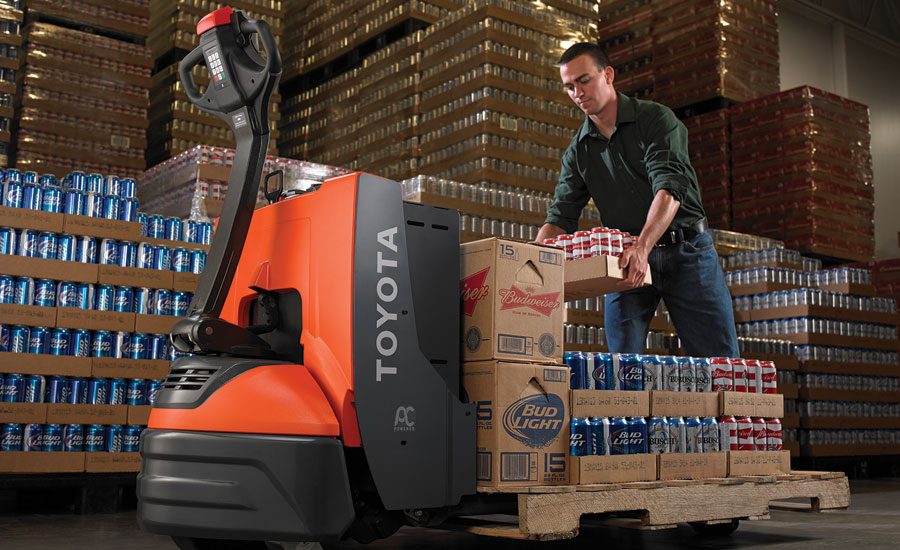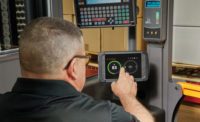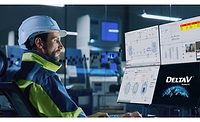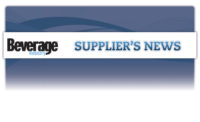Forklifts have long been a staple in beverage warehouses. Yet, demand for new, sustainable technologies, like electric lift trucks, as well as the incorporation of the right combination of slotting and storage strategies to increase capacity and picking efficiency are driving the market.
As SKU proliferation and inventory control continue to challenge beverage operations, the pick face has vertically expanded with heavier loads placed at higher heights, experts note. Mixed-pallet loads, the need to reduce environmental impact, and the use of data-driven intelligence to improve efficiency and protect the bottom line are key drivers impacting the forklift industry.
“One trend we see is that many of our customers are building up, rather than building out, with their warehouses because of real estate costs,” says Andy Smith, director of marketing product management at Crown Equipment Corp., New Bremen, Ohio. “Industry research has shown that it is less expensive to gain pallet positions by going up rather than expanding the warehouse footprint. To give our customers the ability to place heavier loads at higher heights, we have introduced a number of lift trucks that offer faster speeds, more capacities, higher elevations and greater operator control.”
For instance, the Crown TSP Series of turret trucks can reach heights as tall as 675 inches, or six stories, and deliver most loads to full height, while the Crown RM 6000 Series reach truck can reach as high as 505 inches and deliver as much as 1,000 pounds more capacity at height, Smith says. “[The Crown RM 6000] is equipped with forks that travel upward at an industry-leading pace of 160 feet per minute,” he adds.
Shelley Bell, industry manager at Greenville, N.C.-based Yale Materials Handling Corp., also highlights SKU proliferation and the need to find the right combination of space, processes and technology to help manage more diverse inventories.
“Finding this increased capacity requires increasing storage density, building up and locating storage aisles closer together,” Bell explains. “VNA (very narrow aisle) trucks offer a solution to expand storage density by enabling narrower aisle widths and higher storage heights.
“Multi-level lift trucks like the Yale MO25 can expand the so-called ‘golden zone’ of the pick face, enabling operators to easily access products stored at higher levels,” she continues. “Combined with a slotting strategy optimized for this picking range, the use of multi-level trucks can reduce pick time, rack requirements and overall cost per case.”
Martin Brenneman, electric product planning specialist for warehouse products at Toyota Material Handling USA, Columbus, Ind., also notes the challenges that SKU proliferation has created within warehouse operations.
“SKU proliferation and inventory control for any customer are a challenge as too much inventory [on] hand can lead to space-constraint concerns,” he says. “For the beverage industry, in particular, it is a concern as some beverage producers like to promote the ‘Born On’ date of their product to show the end customer the ‘freshness’ of their beverage. The longer the product sits in their warehouse, the closer it is to the expiration date.
“SKU proliferation has also increased the need for mixed-pallet loads,” he continues. “To accomplish this, beverage companies are using layer-picker attachments and implementing low-level order picking with electric pallet jacks.”
Increasing productivity
Crown Equipment’s Smith notes that beverage warehouse executives increasingly are interested in technology and equipment that enable their businesses to be more responsive to the changing interests and expectations of consumers.
“They are asking for solutions that will help them better manage mixed pallets and realize efficiency gains in low-level order picking,” Smith says. “One of the ways we are helping our customers is with the Crown QuickPick Remote order picking system. The system uses semi-automated truck navigation technologies to reduce low-level order picking walk steps, thereby increasing productivity, reducing operator fatigue and improving safety. It cuts ‘truck on/off’ work motions by up to 70 percent, reducing fatigue and improving the operator experience.”
Smith adds that research conducted by Crown shows that the company’s QuickPick Remote system can save as many as five seconds a pick at a 16-foot inter-pick distance. “At 100 picks per hour, QuickPick Remote may generate as much as a
14 percent time savings,” he says.
In addition to time and cost savings, experts note that alternative power options like electric lift trucks, lithium-ion batteries and hydrogen fuel cells can improve operations and aid in sustainability goals.
“[T]hese are becoming increasingly common. While these have long been termed as ‘alternative power,’ I’d ask the question, ‘Is alternative power really alternative anymore?’ It’s easy to see why,” Yale’s Bell says. “Lithium-ion batteries and hydrogen fuel cells are proven to not only reduce environmental impact but protect the bottom line — reducing operating costs while increasing productivity and convenience. Operators should work with their dealer to find out how to best leverage these technologies. For example, lithium ion is especially well-suited for direct-store-delivery applications.”
Bell notes that hydrogen fuel cells produce zero emissions because they generate only water and heat as byproducts. Companies that can generate hydrogen on-site can anticipate a 33 percent reduction in greenhouse gas emissions, compared with lead-acid battery systems charged from an electric grid, he adds.
Los Angeles, Calif.-based BYD America offers the 80V Forklift line, powered by iron-phosphate batteries, which will reduce operation costs while increasing productivity. “How do we do that? Simplification,” says Brian Rippie, sales director in the material handling division. “BYD forklifts charge and go through multiple shifts day after day for 10 years. It’s as simple as that.”
Although costs are associated with the “necessary evils” of running forklift fleets powered by lead-acid batteries, Rippie notes that the right lithium-ion battery from the right company can produce tremendous benefits.
BYD’s iron-phosphate battery, for example, has been safety tested with more than 900 million on-road miles in buses, cars and trucks. Other benefits include the elimination of battery charging rooms. Because no fumes are caused by venting and gassing, no operational hazards are caused by heat and voltage drops in batteries that have a low charge state. Additionally, no toxic materials or heavy metals are present. The batteries also are equipped with environmentally sound secondary life options, he adds.
“BYD has been revolutionizing the rechargeable battery industry since 1995,” Rippie says. “… Included with each BYD forklift is a warranty that will make others jealous — a 10-year warranty on batteries, a five-year warranty on drive axles and three-year warranty on all remaining components.”
Ride and drive
As warehouse managers become more savvy about adopting forklifts that save them money and time, new forklifts are being released.
For example, Norcross, Ga.-based Hyundai Forklift recently introduced the BCS-9 stand-up counter-balanced battery lift truck for narrow aisle operation in the beverage industry. The three new models — 15BCS-9, 18BCS-9 and 20BCS-9 — are available in 3,000-, 3,500- and 4,000-pound capacities.
“Like all Hyundai stand-up battery lift trucks, the smooth-running BCS-9 forklifts feature a compact design that delivers improved work efficiency and maximum space usage,” said Tim Webb, manager of marketing and product development at Hyundai Forklift, in a statement. “The powerful and efficient dual-drive motors with 100 percent AC technology enable superior throughput with faster speed.”
Additionally, Houston-based Mitsubishi Caterpillar Forklift America Inc. (MCFA), the provider of Jungheinrich lift trucks and narrow aisle products in the United States, Canada and Mexico, announced it has expanded its EKX 410-412 electric high-rack turret truck and order picker to a capacity of 2,600 pounds. Other enhancements include new maintenance-free, synchronous AC motors that reduce energy loss by as much as 10 percent while allowing the truck to operate for two full shifts on a single battery charge to provide more pallet moves an hour, the company says.
MCFA’s General Manger of Warehouse Products Perry Ardito highlights its range of electric pallet trucks and sit-down, counter-balanced trucks, which are designed to reduce fleet size while facilitating better picking practices. These include low-level order pickers that elevate the operators beyond the floor and, depending on the rack levels and the spacing of those levels, allows the operator to effectively pick cases as high as 15 feet; high-level order pickers, which facilitate case picking at heights taller than 30 feet; and man-up turret trucks, which can operate as both order and case pickers.
Experts note that the adoption of technological advances in warehouse management solutions — digital scales, handheld RFID scanners and smart telematics — are increasing order picking accuracy and reducing costs.
“We offer both turret trucks and high-level order pickers that feature our semi-automated technology known as Warehouse Navigation, using RFID technology, [which] helps you increase your productivity by up to 25 percent by improving order picking accuracy and reducing costs,” Ardito says. “Transponders embedded in the floor precisely identify aisle locations and distances. Armed with this information, the lift truck takes the most efficient and productive path possible.”
Yale Materials’ Bell also notes the benefits associated with data collection systems for lift trucks.
“For lift truck fleets, telemetry programs like Yale Vision, [are] capable of evaluating utilization, maintenance and other information alongside expected demand and specific truck applications. This data allows fleet managers to make quick, informed decisions about fleet size and composition,” she says. “It can help construct a leaner, more effective fleet by eliminating excess trucks. Additionally, properly utilized telemetry analytics can help refine periodic maintenance schedules to ensure sufficient support without overspending.”
In the future, Toyota’s Brenneman says that original equipment manufacturers will continue to support the growing electric lift truck market. “Forklifts will also become more connected and telematics will help customers analyze their fleets and operations more effectively,” Brenneman says. “… Technology innovation in automation will continue to improve, and, as a result, we expect to see more automation and integrated solutions in the market.”
Crown Equipment’s Smith highlights that the value of the forklift will continue to grow beyond just moving product from point A to point B.
“Crown envisions a connected warehouse in which the forklift becomes not only a roving sensor that reaches parts of the warehouse no other system is reaching, but is also a hub that collects data from various other devices, acts on this data, and consolidates and analyzes it for other systems,” he says. “Forklift connectivity will provide the visibility to manage fleets for greater safety and productivity, and is a key building block of the connected warehouse of the future.” BI





